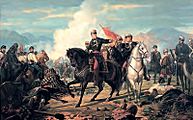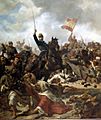Battle of Tétouan facts for kids
Quick facts for kids Battle of Tetuán |
|||||||
|---|---|---|---|---|---|---|---|
| Part of the Hispano-Moroccan War | |||||||
 Oil on canvas painting of the battle by Marià Fortuny. |
|||||||
|
|||||||
| Belligerents | |||||||
| Commanders and leaders | |||||||
| Strength | |||||||
| 36,000 men 65 pieces of artillery 41 ships |
Unknown | ||||||
The Battle of Tetuán was a big fight that happened from February 4 to 6, 1860. It took place near a city called Tetuán in Morocco. This battle was part of the Spanish-Moroccan War that lasted from 1859 to 1860. It was fought between the Spanish army and the local Moroccan forces.
Contents
Why the Battle of Tetuán Happened
The Spanish army decided to send a large force to North Africa. Their main goal was to capture the city of Tetuán. This city was important because it had been used as a base for attacks on two Spanish cities, Ceuta and Melilla. Spain wanted to stop these attacks and secure its borders.
Spanish Forces Prepare for War
The Spanish expedition was very large. It included about 36,000 soldiers and 65 artillery pieces (big cannons). They also had 41 ships, which were a mix of steamships, sailboats, and smaller boats. General Leopoldo O'Donnell was in charge of this whole operation. He divided his forces into three main groups.
- One group was led by General The 5th Marqués de Torreblanca.
- Another group was commanded by General Antonio Ros de Olano.
- The third group was under General Ramón de Echagüe.
General The 1st Conde de Reus led the reserve forces. The navy was commanded by Admiral Segundo Díaz Herrero.
Early Moves in the War
The fighting started on December 17, 1859. General Zavala's group quickly took control of the Sierra de Bullones area. Two days later, on December 19, General Echagüe captured the Palacio del Serrallo. On December 21, another Spanish force landed at Ceuta. By Christmas Day, all three Spanish groups had joined up. They were ready to move forward towards Tetuán.
The Battle of Tetuán Begins
On January 1, 1860, General Prim's group started moving towards the port of Guad al Gelu. General Torreblanca's group and the Royal Spanish Navy protected their side. There were many small fights until January 31, 1860. On that day, the Moroccan forces launched a big attack, but the Spanish stopped them.
Spanish Advance on Tetuán
After stopping the Moroccan attack, General O'Donnell (who was also known as The Conde de Lucena) began his march towards Tetuán. He had help from many Catalan volunteers. Other Spanish units, led by General Prim and General Ros de Olano, provided covering fire. This meant they shot at the Moroccan forces to protect the advancing Spanish troops.
The Fall of Tetuán
The Spanish artillery caused a lot of damage to the Moroccan army. Many Moroccan soldiers were hurt or killed. The remaining Moroccan forces had to retreat and hide inside Tetuán. The city finally fell to the Spanish on February 6, 1860. Even after the city was captured, there was still fighting for about another week before everything became quiet.
What Happened After the Battle
The Spanish victory at Tetuán was important. It stopped the Moroccan forces from attacking Ceuta and Melilla again. After the battle, General O'Donnell and his troops returned to Spain. They camped north of Madrid while a big celebration was planned for their return to the capital city.
Tetuán de las Victorias and O'Donnell's Rise
Over time, the camp where the soldiers stayed became a permanent neighborhood in Madrid. It even got shops and buildings. Today, this area is known as Tetuán de las Victorias, which means "Tetuán of the Victories." Because of his success in the battle, General Leopoldo O'Donnell was given a higher title. He became The 1st Duque de Tetuán (Duke of Tetuán). He later became a very important politician, serving as the Prime Minister of Spain.
Gallery
-
The Battle of Tetuán, by Dionisio Fierros (1894, private collection).
-
General The 1st Count of Reus at the Battle of Tetuán. The title of the painting is "General Prim in the War of Africa" (in Catalan: El General Prim a la guerra d'Àfrica), by Francisco Sans Cabot (1865, formerly at the Barcelona Military Museum, now closed)
See also
 In Spanish: Batalla de Tetuán para niños
In Spanish: Batalla de Tetuán para niños



